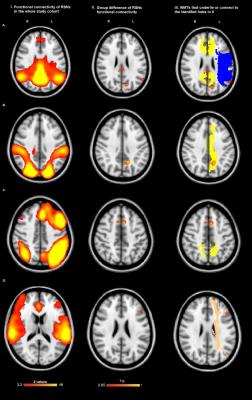2366
The mediating effects of functional disconnection on the association between structural disconnection and cognitive impairment in symptomatic carotid artery disease1Radiological Sciences, Division of Clinical Neurosciences, School of Medicine, University of Nottingham, Nottingham, United Kingdom, 2Sir Peter Mansfield Imaging Centre, School of Medicine, University of Nottingham, Nottingham, United Kingdom
Synopsis
This study investigated the association between functional disconnection of cognitive networks, structural disconnection indexed as microscopic damage of specific white matter tracts, and global cognitive impairment in symptomatic carotid artery disease. The findings regarding the mediating effects of functional disconnection on the association between structural disconnection and global cognitive impairment provided promising implications for future studies that develop therapies for patients with vascular cognitive disorder.
Introduction
Multiple mechanisms have been proposed for vascular cognitive disorder (VCD) while the contribution of each of them on VCD and their interrelations remain unclear1. VCD has been found to be related to infarct characteristics including size and location, white matter hyperintensities, cerebral microbleeds and mixed neurodegenerative pathology2. Radiological evidence for the notion that disconnection of cognitive networks resulting from disrupted white matter pathways may be a key mechanism of VCD have been provided3,4. Functional disconnection is thought to predict post-stroke cognitive impairment better than lesion topography or volumes5, but the possible nature of functional disconnection remains unclear. We hypothesised that functional disconnection of cognitive networks partly mediated the cognitive effects of structural disconnection. The aim of this study was to investigate the possible mediating effects of functional disconnection on the association between structural disconnection and cognitive impairment in symptomatic carotid artery disease.Methods
This prospective study was approved by Local Ethics Committee. Ninety subjects with a carotid stenosis of >30% and a recent non-disabling cerebrovascular event (AF, TIA or stroke) underwent resting-state fMRI, structural MRI and Addenbrooke’s cognitive examination (ACE-R) to define cognitive impairment (ACE-R<82). Seventy-two subjects’ (mean age [SD]:74.2 [10.1]; female: n=27, 37.5%) data passed rigorous quality control. Differences between patients with normal and abnormal global cognition were assessed using dual regression based on independent component analysis6. Increased mean diffusivity (MD) of white matter tracts that underlie or connect to the significantly altered functional connectivity (fc) clusters were used to reflect structural disconnection. To investigate whether functional disconnection of resting-state networks mediated the effect of structural disconnection on cognition, we used the PROCESS macro for SPSS to conduct the mediation analysis. The significance of an indirect effect was tested by bootstrapping with 1000 replications. The percentage of the mediator accounting for the total effect was reported.Results
Cognitively impaired subjects (n=31, classified as probable VCD) showed reduced fc within the default mode network (DMN), dorsal attention network (DAN), left fronto-parietal network (FPN) and salience network (SAL) compared to the cognitively intact patients (n=41) (Figure 1-I,II). After projecting the clusters showing significant difference of network fc, clusters of decreased fc within DMN, DAN, left FPN and SAL in probable VCD subgroup were underlie or connected to cingulum and superior longitudinal fasciculus, left cingulum, cingulum, and left anterior thalamic radiation, respectively (Figure 1-III). There was a significant indirect effect of cingulum MD and left superior longitudinal fasciculus MD on global cognition through PCC fc and precuneous fc within DMN, respectively. PCC fc within the DMN accounted for 34.2% of the total effect of cingulum MD on global cognition and precuneus fc within the DMN accounted for 26.3% of the total effect of cingulum MD on global cognition (Figure 2 A and B). Also, PCC fc within the DAN partially mediated the effect of left cingulum MD on global cognition and it accounted for 24.6% of the total effect (Figure 2 C).Discussion
Findings of the mediation analyses provided the first evidence that resting-state networks (RSNs) fc constituted an important link in the chain between global cognitive performance and structural connectivity indexed as microscopic integrity of network specific white matter tracts in patients with symptomatic carotid artery disease. The identification of RSNs fc as a mediator of the association between structural connectivity and global cognitive performance provided promising implications for future studies that develop therapies for VCD patients. Therapies which have the potential to enhance cognitive networks fc may have beneficial effects on cognition in patients with VCD even though the structural damage is irreversible. Future research are urged to test this hypothesis in patients with VCD as there is no effective treatments for VCD so far.Conclusion
Functional disconnection of cognitive networks accounts for some of the association between structural disconnection, indexed as microscopic damage of specific white matter tracts, and cognitive impairment in probable vascular cognitive disorder.Acknowledgements
This paper presents independent research funded by the National Institute for Health Research (NIHR) under its Research for Patient Benefit (RfPB) Program (Grant Reference Number PB-PG-0107-11438). The views expressed are those of the authors and not necessarily those of the NHS, the NIHR or the Department of Health. None of the sponsors had any role in study design, data collection, data analysis, data interpretation, writing the report, or in decision making to submit the paper for publication.References
1. Sachdev P, Kalaria R, O'Brien J, et al. Diagnostic Criteria for Vascular Cognitive Disorders A VASCOG Statement. Alzheimer Disease & Associated Disorders 2014;28:206-218.
2. Sun JH, Tan L, Yu JT. Post-stroke cognitive impairment: epidemiology, mechanisms and management. Annals of translational medicine 2014;2:80.
3. Duering M, Zieren N, Herve D, et al. Strategic role of frontal white matter tracts in vascular cognitive impairment: a voxel-based lesion-symptom mapping study in CADASIL. Brain : a journal of neurology 2011;134:2366-2375.
4. Meng D, Hosseini AA, Simpson RJ, et al. Lesion Topography and Microscopic White Matter Tract Damage Contribute to Cognitive Impairment in Symptomatic Carotid Artery Disease. Radiology 2016:152685.
5. Siegel JS, Ramsey LE, Snyder AZ, et al. Disruptions of network connectivity predict impairment in multiple behavioral domains after stroke. Proceedings of the National Academy of Sciences of the United States of America 2016;113:E4367-E4376.
6. Beckmann CF, DeLuca M, Devlin JT, Smith SM. Investigations into resting-state connectivity using independent component analysis. Philos T Roy Soc B 2005;360:1001-1013.
Figures

